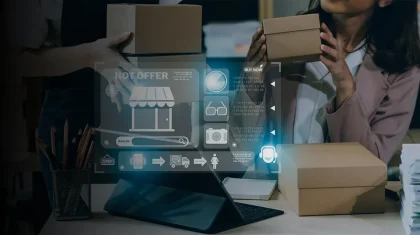
Pre-K Learning: Enhancing Education with Digital Technology
This is the digital age.
A child of age four picks up an iPad and starts a game. Although this isn’t really a game, but rather, it’s a digital learning session. A friendly voice from the iPad says, click on the word bake, which is colored red. The child selects a word, and the voice on the other side says in affirmation, “Correct, good job.” The child smiles and moves to the next learning chapter.
Research confirms that the quality of education and learning received by children in their early years of childhood is essential for their overall development. Children who received high-quality, practical knowledge-based learning in their formative years are less likely to fail in high-school.
Overall, pre-k learning is imperative because the first few years of childhood offer excellent opportunities towards laying a solid advanced learning foundation. When that window is closed, the opportunities decrease, and educational success becomes harder.
Hence, this article will discuss how technology can become a companion for pre-k children.
Benefits of Digital Technology in Pre-K Learning
Children, especially young kids, love gadgets. For a generation that started using tablets, smartphones, and laptops before joining the school, the digital method is the best pre-k learning technique.
Related: 8 Trends in Education Technology That Will Have A Major Impact | 2019
Given below are some of the benefits using digital technologies in pre-k learning:
1. Enhanced Hand-Eye Coordination
Hand-eye coordination is essential in school learning as children have to coordinate their eyes and hands to see and then, write or draw. In digital learning, they are required to follow what is on the screen and use their hands to participate in the learning. This type of coordination is usually found in game-based or video-based pre-k learning applications.
2. Enhanced Language Skills
Due to the ability of technology to provide multisensory learning engagement, digital methods accelerate the learning of a second language. When reading online – e-books, videos, stories, or picture-based learning – children improve their language skills.
Many parents direct their children towards learning a second language by encouraging the child to watch TV shows and cartoons in that language.
Related: 8 Biggest Reasons Why Teachers Prefer eBooks in Classrooms
3. Improved Cognitive Development
Using technology in pre-k learning delivers knowledge in an enjoyable and fun way.
Many educators believe that digital involvement in learning can be harmful to children and thus reduce their concentration. This is true, but only when you let technology-use get out of hand. Pre-k children are still in the early stage of life, and you can shape them and encourage them to learn digitally.
This is necessary because it is hard to ignore the cognitive benefits offered by digital learning. Children who learn through digital methods often exhibit strong problem-solving, conceptual, and reasoning skills. These are the smartest kids you will find on the first day of pre-school.
Apart from better reasoning and conceptual abilities, digital pre-k learning prepares young children for school. They learn basic writing, reading, and math, which makes it easier to adjust in school.
Whitepaper:
The State of Digital Content in Global K-12 Education
4. Increased Visual Attention
Spending time playing learning games allow children to pay attention to details. When you see your child occupied in a game, he is actually calculating his next move and focusing on the visual content of the game.
There are several ways to improve visual attention through digital learning, such as through videos, presentations, games, etc.
Take for example a video asking the child to spot the animal in the forest: The child starts focusing on several aspects of the visual scene of the forest present on their screen. In an attempt to complete the task, the child improves his visual attention along with increasing his/her concentration span.
5. Better Interaction Skills
Since children can better understand and learn languages through digital media, they are more confident when it comes to talking to others. Digital learning helps them develop their vocabulary, thus helping them communicate clearly with others at an early age.
Through the power of language, children are able to better grasp the ideas of other children, along with developing a connection necessary for the interaction.
6. Dynamic Spatial Skills
Digital education content allows children to develop spatial skills. Spatial skill is the capacity to understand the spatial relations among objects or space. It helps kids to visualize shapes in their mind, improving their mental capability to imagine and think. These dynamic skills also help enhance the overall development of the child.
7. Better Problem-Solving Abilities
When children engage in short-term goals or time-based goals, offered by games and video-based learning, they develop problem-solving skills. Later in life, these children become more responsive to sudden changes and thus know how to react to untimely problems.
These children, after joining a school, become more adaptive towards the environment and know how to solve problems in a short span of time.
Some Applications of Pre-K Learning
Here are some examples that can help you understand the uses of digital pre-k learning:
- A learning application that helps students learn pre-k concepts as well as interact and connect with other children of similar age-groups. For example, an app for learning math, which includes questions on addition and subtraction.
- A platform that allows children (whose first language is different) to get acquainted with the local language. For instance, they can use an iPad to convert speech to another language in real-time. Eventually, they would start understanding the local language.
- A video-based learning platform, which involves students in question-based and application-based learning.
Promote Early Literacy with Digital Pre-K Learning
Learning happens when you engage the learner, especially pre-k children as they can get easily distracted. Digital pre-k learning methods can improve early literacy by engaging the learner through appealing graphics, interactive videos, and dynamic learning methods.
We all agree that everything in future will be associated with digital technology. So, getting pre-k kids started on digital learning will only help them in getting acclimatized with the concepts and technology that they would undoubtedly use in the coming years.
Related: How Can K-12 Schools Improve Learning Outcomes with Technology?
Discover how a mobile-first training platform can help your organization.
KITABOO is a cloud-based platform to create, deliver & track mobile-first interactive training content.


